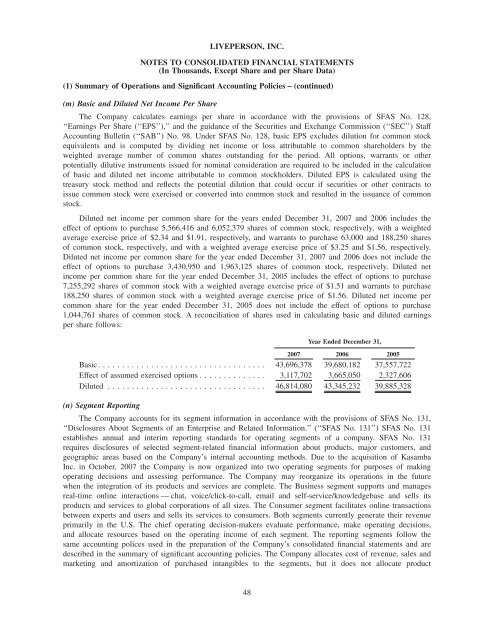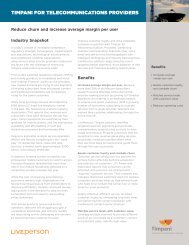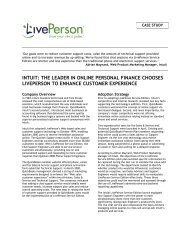Annual Report 2007 - LivePerson
Annual Report 2007 - LivePerson
Annual Report 2007 - LivePerson
Create successful ePaper yourself
Turn your PDF publications into a flip-book with our unique Google optimized e-Paper software.
LIVEPERSON, INC.<br />
NOTES TO CONSOLIDATED FINANCIAL STATEMENTS<br />
(In Thousands, Except Share and per Share Data)<br />
(1) Summary of Operations and Significant Accounting Policies − (continued)<br />
(m) Basic and Diluted Net Income Per Share<br />
The Company calculates earnings per share in accordance with the provisions of SFAS No. 128,<br />
‘‘Earnings Per Share (‘‘EPS’’),’’ and the guidance of the Securities and Exchange Commission (‘‘SEC’’) Staff<br />
Accounting Bulletin (‘‘SAB’’) No. 98. Under SFAS No. 128, basic EPS excludes dilution for common stock<br />
equivalents and is computed by dividing net income or loss attributable to common shareholders by the<br />
weighted average number of common shares outstanding for the period. All options, warrants or other<br />
potentially dilutive instruments issued for nominal consideration are required to be included in the calculation<br />
of basic and diluted net income attributable to common stockholders. Diluted EPS is calculated using the<br />
treasury stock method and reflects the potential dilution that could occur if securities or other contracts to<br />
issue common stock were exercised or converted into common stock and resulted in the issuance of common<br />
stock.<br />
Diluted net income per common share for the years ended December 31, <strong>2007</strong> and 2006 includes the<br />
effect of options to purchase 5,566,416 and 6,052,379 shares of common stock, respectively, with a weighted<br />
average exercise price of $2.34 and $1.91, respectively, and warrants to purchase 63,000 and 188,250 shares<br />
of common stock, respectively, and with a weighted average exercise price of $3.25 and $1.56, respectively.<br />
Diluted net income per common share for the year ended December 31, <strong>2007</strong> and 2006 does not include the<br />
effect of options to purchase 3,430,950 and 1,963,125 shares of common stock, respectively. Diluted net<br />
income per common share for the year ended December 31, 2005 includes the effect of options to purchase<br />
7,255,292 shares of common stock with a weighted average exercise price of $1.51 and warrants to purchase<br />
188,250 shares of common stock with a weighted average exercise price of $1.56. Diluted net income per<br />
common share for the year ended December 31, 2005 does not include the effect of options to purchase<br />
1,044,761 shares of common stock. A reconciliation of shares used in calculating basic and diluted earnings<br />
per share follows:<br />
Year Ended December 31,<br />
<strong>2007</strong> 2006 2005<br />
Basic ................................... 43,696,378 39,680,182 37,557,722<br />
Effect of assumed exercised options .............. 3,117,702 3,665,050 2,327,606<br />
Diluted ................................. 46,814,080 43,345,232 39,885,328<br />
(n) Segment <strong>Report</strong>ing<br />
The Company accounts for its segment information in accordance with the provisions of SFAS No. 131,<br />
‘‘Disclosures About Segments of an Enterprise and Related Information.’’ (‘‘SFAS No. 131’’) SFAS No. 131<br />
establishes annual and interim reporting standards for operating segments of a company. SFAS No. 131<br />
requires disclosures of selected segment-related financial information about products, major customers, and<br />
geographic areas based on the Company’s internal accounting methods. Due to the acquisition of Kasamba<br />
Inc. in October, <strong>2007</strong> the Company is now organized into two operating segments for purposes of making<br />
operating decisions and assessing performance. The Company may reorganize its operations in the future<br />
when the integration of its products and services are complete. The Business segment supports and manages<br />
real-time online interactions — chat, voice/click-to-call, email and self-service/knowledgebase and sells its<br />
products and services to global corporations of all sizes. The Consumer segment facilitates online transactions<br />
between experts and users and sells its services to consumers. Both segments currently generate their revenue<br />
primarily in the U.S. The chief operating decision-makers evaluate performance, make operating decisions,<br />
and allocate resources based on the operating income of each segment. The reporting segments follow the<br />
same accounting polices used in the preparation of the Company’s consolidated financial statements and are<br />
described in the summary of significant accounting policies. The Company allocates cost of revenue, sales and<br />
marketing and amortization of purchased intangibles to the segments, but it does not allocate product<br />
48







